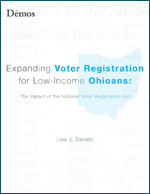Democracy works as intended when all citizens are able to participate and make their voices heard. While the United States has come a long way in expanding the franchise over the past 220 years, barriers to participation still exist and these barriers disproportionately affect low-income citizens. In 2008, the registration gap between low-income and high-income citizens was over 19 percentage points.
Significantly, millions of low-income citizens could be brought into the political process each year by proper implementation of an often-neglected provision (Section 7) of the National Voter Registration Act (NVRA), which requires states to provide voter registration services to low-income persons through public assistance offices. Ohio's experience, which required litigation, provides a case in point, and offers valuable lessons both for advocates and for state officials seeking to encourage voter registration and achieve the full promise of the NVRA.
TOP FACTS:
- Ohio was not regularly providing voter registration services at its public assistance offices. The available data showed little voter registration activity at the state’s public assistance offices and suggested that voter registration opportunities likely were not being provided there. Evidence adduced during the litigation substantiated widespread problems with Section 7 implementation. No state official had exercised oversight or monitored the provision of voter registration services by county offices since the inception of agency-based registration in 1994.
- The U.S. Court of Appeals for the Sixth Circuit unanimously ruled that Ohio state officials were responsible for ensuring that the state’s local public assistance offices were providing voter registration services. Both the Secretary of State, the state’s chief election official, and the Director of the Ohio Department of Jobs and Family Services were liable for violations by local public assistance offices of Section 7 of the NVRA.
- The lawsuit against the state concluded with a comprehensive settlement agreement, establishing a system for providing and overseeing the provision of voter registration services at public assistance offices throughout the state of Ohio. The Settlement Agreement contains many elements, including important requirements concerning notice, procedures, training, data collection, reporting, oversight, and additional services.
- The numbers of voter registration applications submitted to public assistance offices after the settlement agreement showed the substantial improvement in state procedures. In the first six months of reporting under the settlement – January through June 2010 – 101,604 voter registration applications were submitted at the county public assistance offices, averaging 16,900 per month – an improvement of over 950 percent. Before the filing of the lawsuit, by contrast, Ohio was registering only 1,775 persons at public assistance offices each month.

